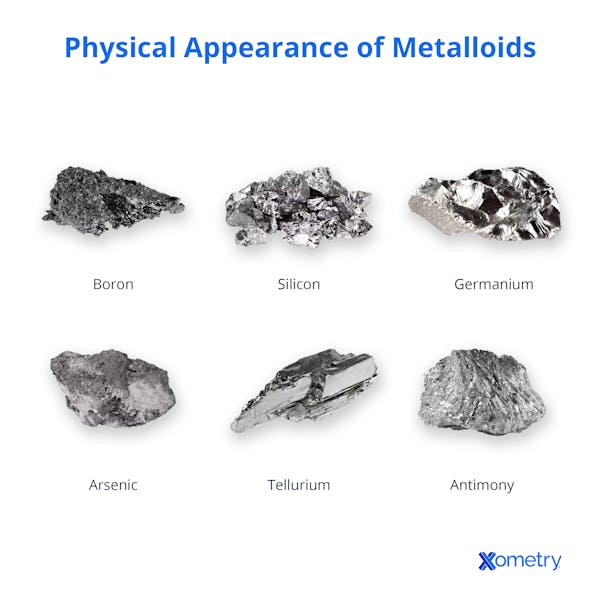Metalloids are a unique and versatile class of chemical elements. Also known as "semimetals," metalloids are typically located along the "stair-step" line on the periodic table, situated between metals and nonmetals. Although they often have a metallic luster, metalloid elements can exhibit properties characteristic of both metals and nonmetals. The extent to which a metalloid displays metallic or non-metallic behavior depends on the specific element and its chemical context.
This article will explore six elements commonly classified as metalloids, their physical and chemical characteristics, as well as their industrial and technological applications.
1. Boron (B)
Boron is a metalloid with the atomic number 5, located on the boundary between metals and nonmetals in the periodic table. In its pure crystalline form, boron is black, lustrous, and extremely hard, with a Mohs hardness of approximately 9.5. Although it has a metallic appearance, boron behaves chemically more like a nonmetal and is a poor conductor of electricity at room temperature, though conductivity improves at elevated temperatures.
Chemically, boron forms stable compounds, such as boric acid and borates, essential in agriculture and pest control. Boric acid and borates are toxic to many insects and arthropods but are generally safe for humans and animals at controlled exposure levels. They are also micronutrients vital for plant development, crucial in cell wall structure, and nutrient transport.
Boron is used across a wide range of industries due to its unique physical and chemical properties, including:
- Steel and alloy production: Enhances hardness, strength, and corrosion resistance.
- Glass and ceramics: Used in borosilicate glass to improve thermal and chemical durability.
- Agriculture: Included in fertilizers as a micronutrient essential for plant health.
- Pest control: Boric acid and related compounds are used as insecticides and wood preservatives.
- Industrial chemicals: Found in detergents, flame retardants, and high-performance ceramics.
2. Arsenic (As)
Arsenic is a metalloid with the atomic number 33. It is well known for its toxicity and potential to disrupt cellular respiration, particularly by inhibiting essential enzymes in ATP production. Despite its hazardous nature, arsenic and its compounds are still used in controlled industrial and agricultural applications.
In its most stable form, gray arsenic, the element has a brittle, metallic appearance and limited chemical reactivity. Arsenic commonly forms trivalent (As³⁺) and pentavalent (As⁵⁺) compounds. It can form up to three covalent bonds, allowing it to bond with various metals and nonmetals, including sulfur and oxygen. While elemental arsenic is relatively inert, certain inorganic and organic arsenic compounds, such as arsine (AsH₃), are highly toxic to both plants and animals.
Arsenic is used across a range of industries due to its metallurgical and pesticidal properties, including:
- Alloying agent: Added to lead and other metals to improve hardness and corrosion resistance, especially in lead-acid batteries and ammunition.
- Wood preservation: Used in chromated copper arsenate (CCA) to protect wood from rot and insect damage (restricted in many countries).
- Agriculture: Formerly used in herbicides and insecticides, though many applications have been phased out due to environmental and health concerns.
- Semiconductors: Used in compounds like gallium arsenide (GaAs) for high-speed electronics and optoelectronics.
3. Silicon (Si)
Silicon is a metalloid with the atomic number 14 and is one of the most abundant elements in the Earth's crust. While pure elemental silicon is rarely found in nature, it is commonly present in silicon dioxide (SiO₂) and silicate minerals, which comprise a large portion of rocks, sand, and soil. In its crystalline form, silicon appears as a hard, dark-gray solid with a metallic sheen.
Despite being a metalloid, pure silicon is a semiconductor, exhibiting poor electrical conductivity at room temperature. Still, its conductivity improves significantly when heat or dopants (like phosphorus or boron) are introduced. This temperature-dependent conductivity makes silicon especially valuable in electronic and photovoltaic applications. Silicon is also chemically reactive at high temperatures, forming stable compounds with oxygen and metals.
Silicon is widely used across multiple industries due to its abundance, thermal stability, and semiconductor properties, including:
- Semiconductors and electronics: The foundational material for integrated circuits, transistors, and solar cells.
- Construction materials: These are used in producing glass, cement, and ceramics, especially silicon dioxide (quartz, sand).
- Alloy manufacturing: Combined with aluminum or steel to improve strength, corrosion resistance, and casting properties.
- Chemical industry: A base component in silicones, which are used in lubricants, adhesives, sealants, and medical implants.
- Enamels and coatings: Added to improve durability and thermal resistance in ceramic glazes and protective coatings.
4. Antimony (Sb)
Antimony is a metalloid with the atomic number 51, known for its use in metal alloys, flame retardants, and semiconductor components. In its elemental form, antimony has a silvery-white, metallic appearance. It is hard and brittle, making it unsuitable for structural use on its own but valuable as an additive to enhance the properties of other materials.
Electrically, high-purity antimony is a poor conductor at room temperature, but like other metalloids, its conductivity improves with temperature, enabling its use in some semiconductor devices. Chemically, antimony can form both trivalent (Sb³⁺) and pentavalent (Sb⁵⁺) compounds and is often found in nature as the sulfide mineral stibnite (Sb₂S₃).
Antimony is used across a variety of industrial sectors due to its flame-retardant properties, metallurgical benefits, and role in electronic components, including:
- Alloy production: Added to lead, tin, and other metals to increase hardness and mechanical strength (e.g., in batteries, bullets, and solder).
- Semiconductors: Used as a dopant in silicon wafers to modify electrical conductivity in diodes and infrared detectors.
- Glass and ceramics: Acts as a fining agent in glassmaking and contributes to opacity and durability in enamels.
- Flame retardants: Key ingredient in antimony trioxide, widely used in plastics, textiles, and electronics to reduce flammability.
- Pigments and coatings: Historically used in paints and pigments (now limited due to toxicity concerns).
5. Tellurium (Te)
Tellurium is a rare metalloid with the atomic number 52, primarily used as an alloy additive to improve machinability, strength, and corrosion resistance. Although relatively scarce in Earth’s crust, tellurium is typically obtained as a byproduct of copper and lead refining, where it occurs in ores such as calaverite and tellurite.
In its elemental form, tellurium is crystalline, silver-white, and brittle, with a metallic luster. It is chemically stable in water but reacts with strong oxidizing agents such as nitric acid. Tellurium shares some semiconducting properties with other metalloids and is used in specialized electronic and thermoelectric applications. It can also form compounds with metals and nonmetals, including tellurides in photovoltaic materials.
Tellurium is used in various high-performance and metallurgical applications due to its unique chemical behavior and alloying ability, including:
- Metallurgy: Added to steel, copper, and lead alloys to enhance machinability, corrosion resistance, and mechanical strength.
- Thermoelectric devices: Used in compounds like bismuth telluride (Bi₂Te₃) for power generation and cooling systems based on temperature gradients.
- Semiconductors: Incorporated into photovoltaic materials such as cadmium telluride (CdTe) in solar panels.
- Chemical catalysts: Function as a catalyst or additive in some chemical reactions and rubber production.
- Glass and ceramics: Used to color glass and improve thermal and optical properties in certain ceramic glazes.
6. Germanium (Ge)
Germanium is a metalloid with the atomic number 32, valued primarily for its use in semiconductors, fiber optics, and infrared optics. It is chemically similar to silicon and shares many semiconducting properties, making it important in the electronics industry. In its elemental form, germanium is hard, brittle, and has a grayish-white metallic appearance.
As a semiconductor, germanium has poor electrical conductivity at room temperature, but its conductivity improves significantly when exposed to heat or when doped with other elements. While it has been largely replaced by silicon in many transistor applications, germanium is still widely used in infrared detectors, fiber-optic systems, and high-speed electronics due to its superior electron mobility.
Germanium is used in a variety of high-tech and optical applications due to its semiconducting behavior and infrared transparency, including:
- Semiconductors and electronics: Used in diodes, transistors, and high-frequency circuits.
- Infrared optics: Applied in thermal imaging systems, night vision devices, and fiber optics.
- Alloy production: Small metals are added to improve corrosion resistance and strength.
- Solar cells: Serve as a substrate material in high-efficiency multi-junction solar cells used in aerospace applications.
- Polymerization catalysts: Certain germanium compounds are used as catalysts in the production of PET plastics.

Frequently Asked Questions About Metalloid Elements
Where on the Periodic Table Can We Find the Elements of Metalloids?
The metalloid elements are found along the “zigzag,” or “staircase” of elements lying between the metals and the nonmetals on the periodic table. They are concentrated in the upper-right portion of the table.
How Are Elements Classified as Metalloids?
Elements that exhibit both metal and nonmetal characteristics, but not solely one or the other, are typically classified as metalloid elements. They are also classified as metalloids based on their ionization energies and electronegativities. These two characteristics flow form the number of valence electrons present in a given type of atom. As you move from left to right on the periodic table, elements become more reactive. Metalloid elements are unique in that when they react with different elements, they sometimes behave like metals and sometimes behave like nonmetals - depending on the element that is reacted with. There is much debate within the scientific community regarding exactly which elements should be considered metalloids. For instance, some scientists may consider selenium (Se) a metalloid, while others would not.
What is the Significance of Categorizing Elements into Metalloids?
The significance of categorizing elements into the category of metalloids is that it allows scientists, chemists, and engineers to predict the properties and reactivity of particular elements. Organizing metalloid elements based on their numbers of valence electrons and material properties makes it much easier.
Are Metalloids Valuable in the Electronics Industry?
Yes, metalloid elements, particularly silicon (Si) and germanium (Ge) are exceptionally valuable in the electronics industry. Without their presence, many of the high-tech and “smart” devices we’re accustomed to today would not be possible. Si and Ge are commonly used as semiconductors. The electrical conductivity of these two elements increases with temperature and with the concentration of impurities added to the base semiconductor through a process called "doping."
As ambient temperature increases, the conductivity of these elements decreases. This makes them excellent conductors at increased temperatures, but insulators at lower temperatures. Doping affects the potential conductivity of Si and Ge by introducing atoms of a different element into their crystalline structure. Doped materials, called “extrinsic semiconductors,” can have different electrical properties than pure semiconductors, which are called “intrinsic semiconductors.” There are two different types of dopants: p-type, or electron acceptors, and n-type, or electron donors, that create p-type and n-type semiconductors. The element used as a doping agent dictates the type of semiconductor that is created.
When coupling doping with increased ambient temperatures, semiconductors can be used to amplify particular electrical currents. Extrinsic semiconductors formed from metalloid elements and their dopants are instrumental in the manufacture of electronic control devices such as: bipolar junction transistors (BJT), field-effect transistors (FET), and metal-oxide semiconductors (MOSFET). Semiconductors are used in many devices we use every day - from temperature sensors to calculators, to solar panels, to computers. None of this would be possible without the presence of metalloid elements.
How Xometry Can Help
This article reviewed a summary of the key properties and uses of 7 common metalloid elements.
Xometry provides a wide range of manufacturing capabilities and value-added services for all of your prototyping and production needs. Visit our website to learn more or to request a free, no-obligation quote.
Disclaimer
The content appearing on this webpage is for informational purposes only. Xometry makes no representation or warranty of any kind, be it expressed or implied, as to the accuracy, completeness, or validity of the information. Any performance parameters, geometric tolerances, specific design features, quality and types of materials, or processes should not be inferred to represent what will be delivered by third-party suppliers or manufacturers through Xometry’s network. Buyers seeking quotes for parts are responsible for defining the specific requirements for those parts. Please refer to our terms and conditions for more information.


